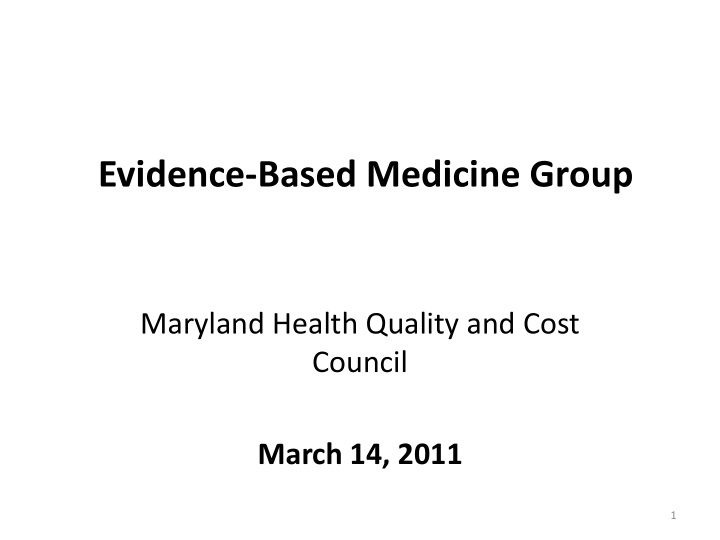



Evidence-Based Medicine Group Maryland Health Quality and Cost Council March 14, 2011 1
Maryland Hospital Hand Hygiene Collaborative Soap & Water Alcoholic hand antiseptics 2
3
Hospital Participation Matrix Status of the Hospital as of Technical Learning Monthly Calls Website & Process HandStats Listserve September 1, 2010 Assistance Sessions & Webinars Tools Measures Full compliance: Standard training Unknown observers √ √ √ √ √ √ √ All units involved 30 observations/unit/month Process measures Non-compliant: √ √ √ √ √ Not using unknown observers 4
Maryland Hospital Hand Hygiene Collaborative Participation Status Acute Care (N = 42) Specialty (N = 5) Not Participating Not Participating 2 = 40% 11 = 26% Participating Participating 31 = 74% 3 = 60% **N = number of hospitals previously committed to program. Overall, 67% of Maryland acute care general hospitals are participating in the Collaborative** 5
**Includes only acute care hospitals with at least an 80% participation rate among required units**
HH Compliance on "Exit" Measure by Month Sep 2010 - Jan 2011 100% 90% 76% 76% 80% 75% 72% 70% 70% % Hand Hygiene Compliance 60% 50% 40% 30% 20% 10% 0% Sep Oct Nov Dec Jan (N = 25) (N = 23) (N = 20) (N = 21) (N = 23) Month **Includes only acute care hospitals with at least an 80% participation rate among required units**
Current/Next Steps of the Hand Hygiene Collaborative • Strengthen Capability of Hospital Programs: •Monthly Hand Hygiene team calls/webinars •Technical assistance calls •Targeted site visits •CEO and Executive Sponsor report card •Validation of standard methodology • Continue Collaborative past the original June 2011 termination date • Comparison of HH compliance to HAIs • Consider program expansion •Additional acute care hospitals •non-acute care hospital settings (e.g., long term care, ASC) 8
CLABSI- Updates Participation: • 41 acute care hospitals, 3 specialty • 76 total units – 57 ICUs – 19 Medical/Surgical or Other Recent and Ongoing Activities: • Hospital Survey Of Patient Safety (HSOPS) survey • Monthly Team Check Up Tool • CLABSI data submission • Monthly Calls- national content, Maryland coaching calls • Kick-off meeting
Kick –Off Meeting December 6 • Over 300 participants including: Executives, Physicians, Nurses, Managers, Safety Officers, and Infection Preventionists • Agenda: On The CUSP: Stop BSI overview, leading change, data management, improving communication, and learning from defects • Overall program rating (167 respondents) – Good- 11% – Very Good- 47% – Excellent-42% • Value of Session – Program details – Networking, discussion – Call to action, enthusiasm – Tools and exercises
Areas of Participant Concern • Administration/Leadership Support • Lack of Resources • Staff Engagement (nurse, physician) • Communication • Implementation and Sustainability • Clinical Practice (following the checklist) • Culture
CLABSI Data Reports Data Comparisons Organizational Unit • • Maryland • National Comparative
Maryland Regulated Medical Waste (“RMW”) Reduction Collaborative 14
Next Steps Regulated Medical Waste • DHMH to staff project beginning Summer 2011
18
Maryland Blood Wastage Collaborative Work Group Members • Co-Chairs: Page Gambill, American Red Cross Donna Marquess, LifeBridge Health • Members: Joan Boyd, JHH Janice Hunt, UMM Mary Mussman, DHMH Lisa Shifflett, JHH • Facilitator: I-Fong Sun, JHM 19
Total Savings for State: 15 Months (*as of February 22, 2011) • Platelets = 763 units • Platelets = $387,176 • 35* out of 44 hospitals have submitted November data • Plasma = 492 units • Plasma = $27,015 = 80% participation rate • Allo Red = 43 units • Allo Red = 10,313 • Auto/Dir Red = -185 units • Auto/Dir Red = ($65,462) Total Units Saved Total $s Saved =1255 units = $414,191 *Note: The Collaborative’s focus has been on platelets and plasma based on the project charters. Thus, Allo Red and Auto/Dir Red Cells have been excluded in the calculations. 20
Inventory Visibility System Currently in 30 facilities Features: (including those in the DC Metropolitan • Post expiring inventory area) with future expansion across the • Claim posted inventory Nation • Acknowledge requested transfer 21
New Goals for CY11 Platelets: Reduce Effective Wastage Rate by 7% = 240 Units = $121K SAVED Plasma: Reduce Effective Wastage Rate by 10% = 453 Units = $25K SAVED 22
Blood Wastage Prevention Next Steps • Collaborative Meeting: March 14, 2011 • Inventory Visibility System (aka Craig’s List) – Continue to work with facilities to increase use – Expand types of products that are posted • Provide training for new staff: Date is TBD • Publish results 23
Next Steps, EBM* Workgroup • Analysis of HAIs and HH compliance • Expansion of HH Collaborative to other non-acute care hospital settings • Solicit feedback from provider, payer , quality improvement organizations across settings regarding initiatives for consideration of action – Bring items to Council’s June 10, 2011 meeting 24 *Short term, quick wins
Recommend
More recommend